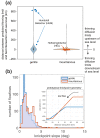Steep Glacier Bed Knickpoints Mitigate Inland Thinning in Greenland
- PMID: 33678924
- PMCID: PMC7900969
- DOI: 10.1029/2020GL090112
Steep Glacier Bed Knickpoints Mitigate Inland Thinning in Greenland
Abstract
Greenland's outlet glaciers have been a leading source of mass loss and accompanying sea-level rise from the Greenland Ice Sheet (GrIS) over the last 25 years. The dynamic component of outlet glacier mass loss depends on both the ice flux through the terminus and the inland extent of glacier thinning, initiated at the ice-ocean interface. Here, we find limits to the inland spread of thinning that initiates at glacier termini for 141 ocean-terminating outlet glaciers around the GrIS. Inland diffusion of thinning is limited by steep reaches of bed topography that we call "knickpoints." We show that knickpoints exist beneath the majority of outlet glaciers but they are less steep in regions of gentle bed topography, giving glaciers in gentle bed topography the potential to contribute to ongoing and future mass loss from the GrIS by allowing the diffusion of thinning far into the ice sheet interior.
© 2020. The Authors.
Figures



References
-
- Bevan, S. L. , Luckman, A. J. , & Murray, T. (2012). Glacier dynamics over the last quarter of a century at Helheim, Kangerdlugssuaq and 14 other major Greenland outlet glaciers. The Cryosphere, 6(5), 923–937. 10.5194/tc-6-923-2012 - DOI
-
- Bindschadler, R. A. (1997). Actively surging West Antarctic ice streams and their response characteristics. Annals of Glaciology, 24, 409–414. 10.3189/s0260305500012520 - DOI
-
- Carr, J. R. , Stokes, C. , & Vieli, A. (2014). Recent retreat of major outlet glaciers on Novaya Zemlya, Russian Arctic, influenced by fjord geometry and sea‐ice conditions. Journal of Glaciology, (60)(219), 155–170. 10.3189/2014jog13j122 - DOI
-
- Catania, G. A. , Stearns, L. A. , Sutherland, D. A. , Fried, M. J. , Bartholomaus, T. C. , Morlighem, M. , Shroyer, E. , & Nash, J. (2018). Geometric Controls on Tidewater Glacier Retreat in Central Western Greenland. Journal of Geophysical Research: Earth Surface, 123(8), 2024–2038. 10.1029/2017jf004499 - DOI
-
- Csatho, B. M. , Schenk, A. F. , van der Veen, C. J. , Babonis, G. , Duncan, K. , Rezvanbehbahani, S. , van den Broeke, M. R. , Simonsen, S. B. , Nagarajan, S. , & van Angelen, J. H. (2014). Laser altimetry reveals complex pattern of Greenland Ice Sheet dynamics. Proceedings of the National Academy of Sciences, 111(52), 18478–18483. 10.1073/pnas.1411680112 - DOI - PMC - PubMed
References From the Supporting Information
-
- Cuffey, K. , & Paterson, W. S. B. (2010). The physics of glaciers (4th ed.). Academic Press.
-
- Howat, I. M. , & Eddy, A. (2011). Multi‐decadal retreat of Greenland’s marine‐terminating glaciers. Journal of Glaciology, 57(203), 389–396. 10.3189/002214311796905631 - DOI
-
- Hutter, K. (1983). Theoretical glaciology: Material science of ice and the mechanics of glaciers and ice sheets. Dordrecht, The Netherlands: Reidel Publishing.
-
- Joughin, I. , Smith, B. , Howat, I. , & Scambos, T. (2016). MEaSUREs Multi‐year Greenland Ice Sheet Velocity Mosaic, Version 1. Boulder, CO: NASA National Snow and Ice Data Center Distributed Active Archive Center; 10.5067/QUA5Q9SVMSJG - DOI
LinkOut - more resources
Full Text Sources
Other Literature Sources
Miscellaneous
